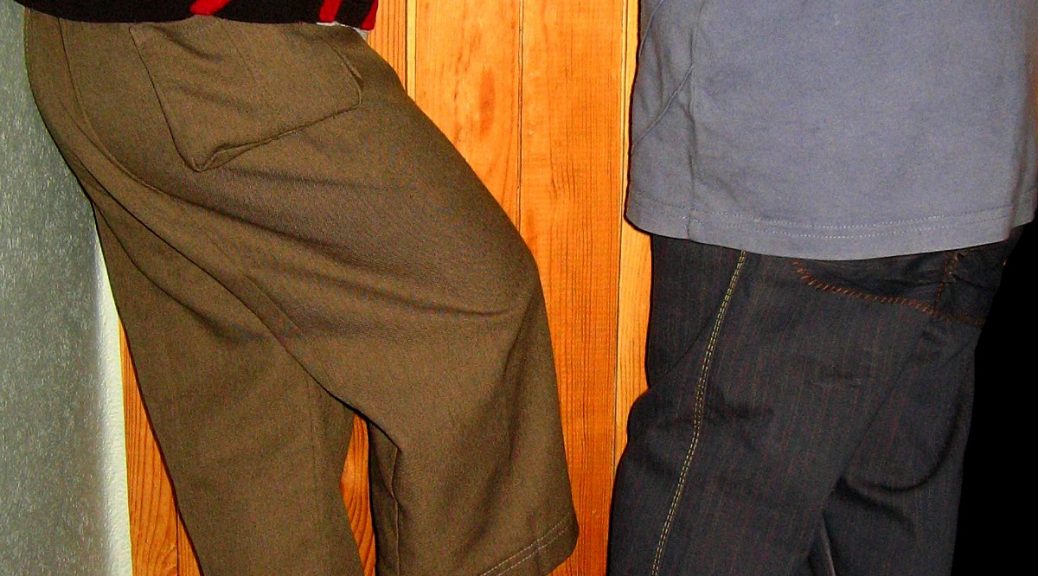
New and original ideas for the design of children's clothing. Original and simple solutions that will help you make an excellent gift to your child. Simple instructions and photos
Classic pants will be useful to any boy. They can be dressed for various celebrations, school, and generally worn daily. Each wardrobe should have pants, regardless of the boy or the girl. Below you will find general recommendations for sewing classic trousers for a boy. It's simpler to go to the market and buy pants for your son, but this method is not economical. Children grow fast, and buying trousers for a season for fabulous money is not the best option. The way out is sewing. This method is much cheaper, and if you start to work with love, then the trousers will turn out all right. 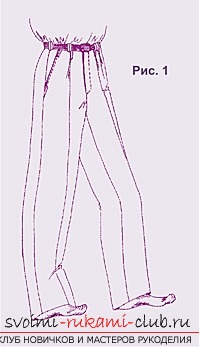 By the way, the model can be sewn out of suit fabric,and also from already worn men's trousers. Let us consider in more detail the moments that cause the most difficulties: the marking of zauteuzhkov, the cutting of parts and pockets. To begin with, what details will be needed for sewing classic trousers: For classic trousers for a boy there should be such details:
By the way, the model can be sewn out of suit fabric,and also from already worn men's trousers. Let us consider in more detail the moments that cause the most difficulties: the marking of zauteuzhkov, the cutting of parts and pockets. To begin with, what details will be needed for sewing classic trousers: For classic trousers for a boy there should be such details:
- Front half of the 2 pattern;
- 2 burlap;
- Lining 2 pieces;
- Pocket outfits 2 pieces;
- Rear half 2 parts;
- Details for belt 2 pieces;
When all the details are cut, you need to double-check again. And only then you can start sewing. 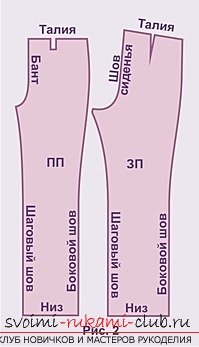 Line zayutyuzhki required to place it so that it is equidistant at the bottom of the trousers themselves from the step seam and the side. See figure 3.
Line zayutyuzhki required to place it so that it is equidistant at the bottom of the trousers themselves from the step seam and the side. See figure 3. 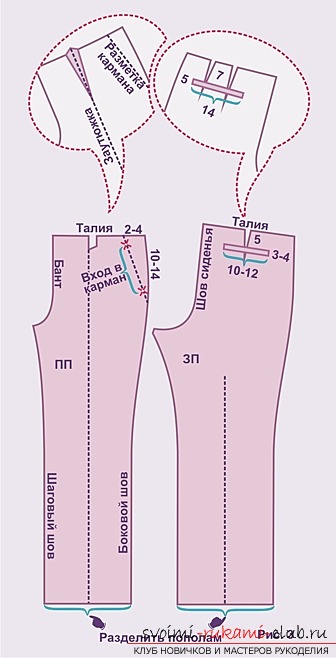 Therefore, it is worthwhile to mark out the pattern by folding the templatein half. Some may ask the question: "Why do we need this line in the diagram?". It is necessary on this pattern only in order to properly mark a dash or a warehouse. The warehouse should be located directly next to the line zatyuyuzhki, and mainly from the pockets. A small note. The warehouse can be located on the back side of the jaw, in other words, near the buckle in the pants with large warehouses at the waist. This can be done when there is no way to sew all the warehouses in the pocket area. It should be noted at once that during the processing of patterns, the line of jaws will not be needed at all, because when smoothing the front half of the pattern, we will fold it in half, and afterwards it will be oriented downwards to the complete coincidence of the side seam with the step seam, and above - to the processed warehouse or tuck . Marking the very dart of the front half is different from the layout of the warehouses. For comparison, see Figure 3, where everything is indicated. Note that the vertical of the jaw acts as the midline of the dart. How to choose the length of the dart? It all depends on age. For children's trousers it is enough to measure 4-7 centimeters. How to put a tart solution? It is required to postpone half-way on both sides of the jaw. For children's trousers - 0,7-1,5 centimeters. Now it is necessary to understand the layout of the "Hungarian" pocket, it is also called "cutting barrel". She is "tied" to the marking of the zautyuzhka. The most important rule that needs to be met is keeping the right distance from the pocket to the dart or the warehouses. It must be no less than half the width of the warehouse, and it is better to add to the resulting value of 1.5 centimeters. This rule should be taken into account, especially if the size is small, and the warehouse is 2 or even 3.
Therefore, it is worthwhile to mark out the pattern by folding the templatein half. Some may ask the question: "Why do we need this line in the diagram?". It is necessary on this pattern only in order to properly mark a dash or a warehouse. The warehouse should be located directly next to the line zatyuyuzhki, and mainly from the pockets. A small note. The warehouse can be located on the back side of the jaw, in other words, near the buckle in the pants with large warehouses at the waist. This can be done when there is no way to sew all the warehouses in the pocket area. It should be noted at once that during the processing of patterns, the line of jaws will not be needed at all, because when smoothing the front half of the pattern, we will fold it in half, and afterwards it will be oriented downwards to the complete coincidence of the side seam with the step seam, and above - to the processed warehouse or tuck . Marking the very dart of the front half is different from the layout of the warehouses. For comparison, see Figure 3, where everything is indicated. Note that the vertical of the jaw acts as the midline of the dart. How to choose the length of the dart? It all depends on age. For children's trousers it is enough to measure 4-7 centimeters. How to put a tart solution? It is required to postpone half-way on both sides of the jaw. For children's trousers - 0,7-1,5 centimeters. Now it is necessary to understand the layout of the "Hungarian" pocket, it is also called "cutting barrel". She is "tied" to the marking of the zautyuzhka. The most important rule that needs to be met is keeping the right distance from the pocket to the dart or the warehouses. It must be no less than half the width of the warehouse, and it is better to add to the resulting value of 1.5 centimeters. This rule should be taken into account, especially if the size is small, and the warehouse is 2 or even 3. 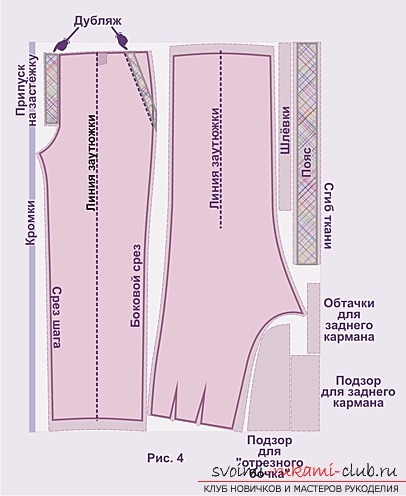 If you, such a case, then most often pocketIt is required to do in a lateral seam so that allowances to the warehouse do not interfere during the processing of the pocket and the whole product. For sewing children's classic trousers, the width of the "detachable barrel" at the top is 2-4 centimeters, and the length is 10-14 centimeters. How to check the correctness of the markup? It is necessary to let go of the received line from above and below somewhere 2-2.5 centimeters, which are necessary to process the seams and fix the pocket. Then compare the resulting segment with the palm of your boy. Now we proceed to marking the dart on the back half of the children's trousers. It's simple: by the waistline of the back half perpendicularly draw a line. It will be the middle tuck line, and then measure half the solution of the tuck shown on the different sides of the midline. The solution of the dart for the classic trousers for the boy is 1-1.5 centimeters, the length is 4-6 centimeters. Do not forget that darts on the back half of the product play an important role, in addition to fitting, they strengthen the pocket of the rear half. From all this it follows that the marking of the pocket of the rear part depends on the very marking of the darts. The distance from the waist to the pocket for children's classic trousers will be about 5 centimeters, from the side cut - 3-4 centimeters, and the length - 10-12 centimeters. In Figure 4, you can look in more detail at the cutting of children's classic trousers with dubbing and we cover up the smallest details. As you can see, the allowance for the buckle is duplicated, the detachable barrels are placed just above the marking line, and the belt is made with indentations of 1 centimeter. It is worth saying that in children's trousers the width of the belt is far from the usual standards of stock. In all pants per adult, in most cases, the width of the belt depends on the width of the corsage belt, but in the children's pants - from the belt worn by the child. For example, consider this case: the width of the belt is 2.5 centimeters. In other words, the width of the belt in the finished form should be about 2-2.3 centimeters. This is necessary in order for the belt to overlap the width of the belt. Already ready for the width of the belt, you need to add 2 allowances one centimeter from each side. The length of the belt can be learned from such a formula: fold fabric + 10-12 centimeters. These values include a transitional part in the front, as well as a margin for rearward protrusion.
If you, such a case, then most often pocketIt is required to do in a lateral seam so that allowances to the warehouse do not interfere during the processing of the pocket and the whole product. For sewing children's classic trousers, the width of the "detachable barrel" at the top is 2-4 centimeters, and the length is 10-14 centimeters. How to check the correctness of the markup? It is necessary to let go of the received line from above and below somewhere 2-2.5 centimeters, which are necessary to process the seams and fix the pocket. Then compare the resulting segment with the palm of your boy. Now we proceed to marking the dart on the back half of the children's trousers. It's simple: by the waistline of the back half perpendicularly draw a line. It will be the middle tuck line, and then measure half the solution of the tuck shown on the different sides of the midline. The solution of the dart for the classic trousers for the boy is 1-1.5 centimeters, the length is 4-6 centimeters. Do not forget that darts on the back half of the product play an important role, in addition to fitting, they strengthen the pocket of the rear half. From all this it follows that the marking of the pocket of the rear part depends on the very marking of the darts. The distance from the waist to the pocket for children's classic trousers will be about 5 centimeters, from the side cut - 3-4 centimeters, and the length - 10-12 centimeters. In Figure 4, you can look in more detail at the cutting of children's classic trousers with dubbing and we cover up the smallest details. As you can see, the allowance for the buckle is duplicated, the detachable barrels are placed just above the marking line, and the belt is made with indentations of 1 centimeter. It is worth saying that in children's trousers the width of the belt is far from the usual standards of stock. In all pants per adult, in most cases, the width of the belt depends on the width of the corsage belt, but in the children's pants - from the belt worn by the child. For example, consider this case: the width of the belt is 2.5 centimeters. In other words, the width of the belt in the finished form should be about 2-2.3 centimeters. This is necessary in order for the belt to overlap the width of the belt. Already ready for the width of the belt, you need to add 2 allowances one centimeter from each side. The length of the belt can be learned from such a formula: fold fabric + 10-12 centimeters. These values include a transitional part in the front, as well as a margin for rearward protrusion. 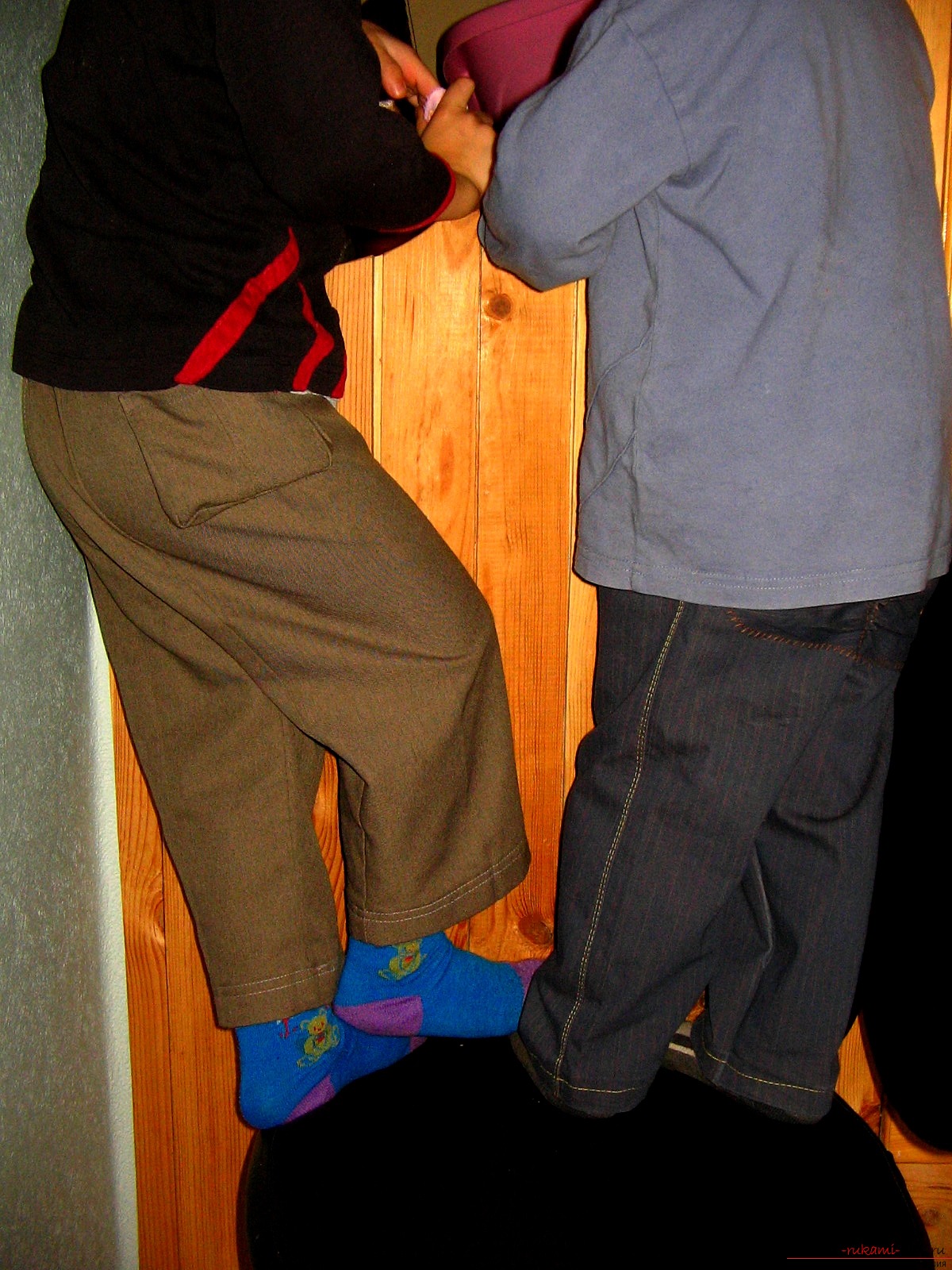 These are all recommendations that should be taken into account during the cutting and sewing of children's trousers on the boy.
These are all recommendations that should be taken into account during the cutting and sewing of children's trousers on the boy.




